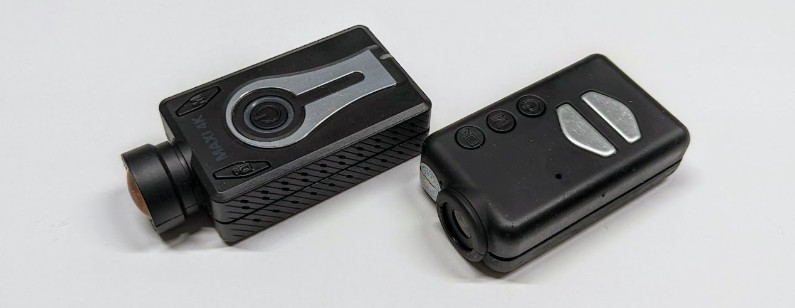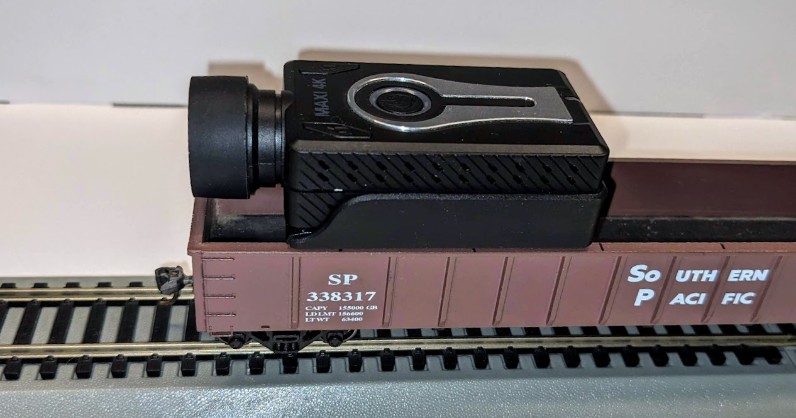Model Train-related Notes Blog -- these are personal notes and musings on the subject of model train control, automation, electronics, or whatever I find interesting. I also have more posts in a blog dedicated to the maintenance of the Randall Museum Model Railroad.
2023-01-01 - Mobius Maxi 4K
Category Video
I’ve done a number of “cab ride” videos at the Randall Museum layout over the last few months using a Mobius Maxi 4K camera. Here’s a summary of the pros and cons of this camera, and the setup I use for filming.
In the past, I’ve done my cab ride videos mostly using a Mobius v1 Action Cam. I’ve also tried the Runcam 2, the SQ12, and the SQ23 camera, so I’ll compare it to these as well.
The Mobius Maxi 4K (left) vs the Mobius v1 (right).
Size
The Mobius Maxi 4K fits perfectly on an HO-size gondola or flat car, and fits in the NMRA HO gauge with lots of room to spare:
Comparison
The previous Mobius “v1” Action Cam that I was using was a 1080p camera. I liked it back then because the form factor was good -- at 1 inch wide, it fit perfectly on a HO flat car (as shown above with the Maxi 4K). Back then the only suitable alternative was the older GoPros which were much larger. The Mobius v1 camera view has some barrel distortion, and I always used to center-crop the image to 720p. That removed all the barrel distortion. Eventually I outgrew that resolution -- nowaday I want 1080p content -- which means I need a larger resolution and crop into it. The Maxi 4K fits that perfectly.
In between I tried other cameras, such as the Runcam 2. Initially I was attracted by the wifi connection aspect of that camera -- one problem with the Mobius v1 is that there’s no way to know what the view of the camera looks like beforehand, so it’s impossible to set it up correctly. The Runcam 2 would have fixed that except I had a lot of issues with it (unreliable sound, unreliable wifi connection, bad lens alignment).
The Mobius Maxi 4K Is fairly similar in size and behavior to the Mobius v1, adds 4K video which I can crop to 1080p, and adds the optional wifi I was lacking. In short, after having used it for around 6 months, it’s pretty good at what it does and it’s my go-to camera for cab rides now.
Features
Comparing the Mobius Maxi 4K to previous cameras I’ve tried:
- Runcam 2: The Runcam was “almost” a good replacement for the Mobius v1, except it was “death by a thousand cuts” -- the sound recording volume was bad, the lens was initially poorly focused, the wifi was unreliable. And it was only a 1080p camera, thus in that regard it did not add much more than the Mobius v1 itself.
- The SQ12 and the SQ23 cameras had an attractive form factor (a little cube); their major flaws was that they were really 720p @ 25 fps cameras advertised as 1080p @ 30 fps, using interpolation to make the image bigger and a 2:3 pulldown to inject duplicate frames to produce a fake 30 fps stream. So in essence, a full marketing lie.
What I like about the Mobius Maxi 4K:
- The form factor is excellent for my usage. It fits neatly on an HO-sized flat car or gondola. More on this in the next post.
- It has a low height profile, which works very well for this application, unlike GoPro-like cameras which tend to be more vertical. The Mobius Maxi 4K has tunnel clearance, and fits in the NMRA HO profile gauge.
- The “native” resolution is 3840 x 2160, aka “4K”. To be clear, I do not produce 4K videos! I only produce 1080p videos, so why bother? The larger resolution means I can center-crop the video in the editor to extract the center 1080p portion of it, without rescaling. Combined with the integrated Lens Distortion Correction (LDC), this essentially removes all the barrel distortion in the final video.
- Because I extract 1080p from a 4K image, I can pan right-left for a better view in curves at editing time.
- Interaction with the camera is done using 3 buttons at the top which are fairly intuitive. They kept the same buttons as with the Mobius v1, so that helps a lot in familiarity: power button (on/off/wifi), recording button, and mode button (2 banks of settings can be used, more on that later).
- The camera records to an SD Card. It has USB C, and with a Windows 10/11 computer we have direct access to the files.
- There is now wifi support, and an app can be used on Android or iPhone to view the video. To be clear, the mobile app is rather meh, but it does get the job done to get a view from the camera.
- Configuration can still be done using the external Windows-only mSetup app as before. This is a very simple & well-done app, and it really gets the job done to allow each and every feature to be controlled easily.
- My video recording sessions typically involve running the camera for one hour continuously, and the battery handles that just fine.
Now the downside. There are a few minor issues and there are a number of a features that I do not use on the Mobius Maxi 4K, because they are irrelevant to me, or do not make sense:
- The 4K mode is 30 fps. Forget the advertised 60 fps. There’s a 2.7K (2704x1520) @ 60 fps mode, which would be very appealing for my type of videos. But that’s a lie in the sense that the recorded stream is still a 30 fps video where each frame is duplicated twice! Not only is this a pointless feature, but it actually totally ruins the motion stabilization algorithm in DaVinci Resolve. Thus for my usage, only 30 fps should be used.
- There’s an Electronics Image Stabilization option but I can’t use it in 4K 30 fps because it requires to turn Lens Distortion Correction off.
- There’s an Auto Low Light feature that is great to capture more light e.g. in dark tunnels, but unfortunately the camera does that by switching the recorded stream from 30 fps down to 15 fps, and then duplicating every frame. Not only does it look more choppy, but, again, that totally ruins the motion stabilization algorithm in DaVinci Resolve so I can’t use it.
- Wifi, as with the Runcam 2, uses a lot of power out of the small battery, so it’s not really a good suitable recording mode. I sometimes enable it to set up the camera, then turn the wifi off and record on the sdcard.
- I don’t know if it’s due to the limited Android app or the camera, but I cannot record on the sdcard while the Android app records via the wifi. Given the workflow above, that’s not a big issue, yet it’s important to know that limitation.
- The recorded video is a bit on the “flat” side. I really need to boost color saturation & contrast in DaVinci Resolve. The white balance is fairly correct even with the inconsistent lighting we have on the model railroad.
- Be very careful with cheap AC-based LED drivers as they easily tend to produce banding. I’ll expand on that in the next post.
- From the Mobius v1 experience, eventually the battery will degrade and not last as long -- this tech of battery tends to last about 3 years if left to deplete. The v1 contains a small LiPo battery. On the plus side, it's a fairly common type of battery and one can easily find replacements for around $10 on Amazon or eBay.
Settings
Like the Mobius cam v1, these are 3 modes: video 1, video 2, and photo (e.g. time lapse). I never use the photo/time lapse mode. I do use video modes 1 & 2 to customize the sound microphone volume: I use a default recording audio volume of 75%. It works well when the camera is at the back of the train or the engine, yet it results in a lot of clipping when next to an engine with a very loud sound reflecting in windows or tunnels. For that case, I have the other video mode with audio recording level set at 50%.
Mode 1 (orange) |
Mode 2 (blue) |
50 Hz NTSC, gravity off, power off 30s ----- Timestamp Off, Rec Indicator On, No rotate. Audio Volume 50% Loop Off (stops when full). Format MP4 FOV Wide, WDR On. 4K 30 fps (3840 x 2160) Video Quality High Video Len 10 min ----- Auto Low Light OFF Slow Mo Off, Motion Detect Off, Lapse Off EIS Off (cannot be used with LDC) LDC Lens Distortion ON (for both modes) Output Gyro Data off |
50 Hz NTSC, gravity off, power off 30s ----- Timestamp Off, Rec Indicator On, No rotate. Audio Volume 75% Loop Off (stops when full). Format MP4 FOV Wide, WDR On. 4K 30 fps (3840 x 2160) Video Quality High Video Len 10 min ----- Auto Low Light OFF Slow Mo Off, Motion Detect Off, Lapse Off EIS Off (cannot be used with LDC) LDC Lens Distortion ON (for both modes) Output Gyro Data off |
To adjust the settings, use the mSetup app by finding it here:
- Go to this reseller page,
- In there there’s a link to the user manual.
- Scroll down and there’s a “Windows Software” link to the mSetup app.
- There are links to the “iSmart DV2” app that can be used on either Android or iPhone to use the camera over wifi.
The mSetup app can also be used to update the firmware on the camera.
In the next post, we’ll look at how I use that camera. I have a number of videos on my channel using this camera, here are some of them:
Follow up read: How I use this camera using a custom camera-car.



